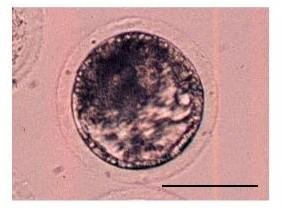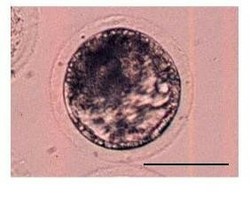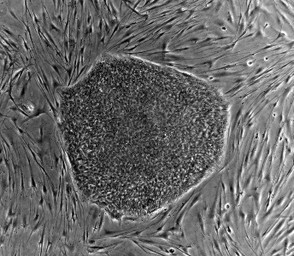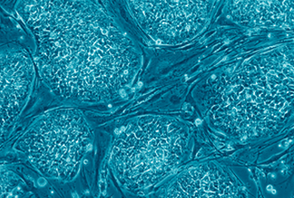Embryonic stem cells are one of the many different types of stem cells, scientists use for research, and more recently, therapeutic purposes. As implied by their name, they are called “embryonic” as they are extracted by embryos that are in a very early developmental stage (a morula or a blastocyst).

Embryonic stem cells
by KakashiNar
What are embryonic stem cells, where are they extracted from and which are their potential applications.
Where are embryonic stem cells extracted from ?
As mentioned before, embryonic stem cells are extracted by embryos. They are either extracted from a morula or from a blastocyst. Morula is essentially, a very young embryo that only consists of about 32-100 cells whereas the blastocyst is the next embryonic stage and is formed 4-5 days after fertilization.
Unfortunately, the extraction process destroys (or kills if you prefer) the embryo, and this is why many people object the use of embryonic stem cells (what is commonly known as the embryonic stem cell controversy).
The first successful extraction of embryonic stem cells, from mouse embryos, occurred in 1981 by Martin Evans and Matthew Kaufman from the Department of Genetics, University of Cambridge.
James Thomson at the University of Wisconsin-Madison was the first researcher who developed a method for the extraction of human embryonic stem cells (hESCs).
In 2006, researchers from Advanced Cell Technology announced a new ESC extraction method that doesn’t destroy the embryo. As of now, the method has only been tried out in mice.
 A swine blastocyst |
What cells can ESCs develop into?
Unlike adult stem cells, ESCs have the capacity to transform into virtually all different types of somatic cells (specialized cells like neurons or platelets) the originating organism has. This means that they can theoretically form all tissues and organs. To be more specific:
- ESCs derived from a morula are totipotent, having the capacity to develop into all cells, no exceptions made.
- ESCs derived from a blastocyst are pluripotent, meaning that they can again transform into all kinds of cells, with only one exception, the cells forming the placental tissue.
ESCs potential therapeutic applications
Similarly to their name, ESC research is still on an embryonic stage. As of today (2013), there is not even one FDA-approved, ESC-based treatment. However this is expected to change very soon as there is a lot of research going on.
The first embryonic stem cell clinical trial on humans, with debilitating spinal cord injuries, began on January 23, 2009 however it was cancelled a few years later, supposedly for financial reasons. Very few patients actually enrolled and the company running the trial (Geron Corporation) has yet to make an announcement regarding their progress.
A company named Advanced Cell Technology (ACT) has already received approval by the FDA to commence human ESC clinical trials on patients with the following conditions:
- Macular Dystrophy
- Dry Age-Related Macular Degeneration
- Severe Myopia
Human embryonic stem cells as models for genetic disorders
There are a few genetic conditions for which currently there is no animal model that researchers can use to study them. For instance:
- Fragile-X syndrome
- Cystic fibrosis
Video about embryonic stem cells
You might also like
Bless You and Gesundheit - Why Do We Say This When People Sneeze?Have you ever wondered what bless you and gesundheit means and why people say...
Ways Native Plants Can Help Control Invasive PlantsPlanting or growing native plants can help to control invasive plants in nume...





 Dog Training: Essential Equipmenton 12/14/2016
Dog Training: Essential Equipmenton 12/14/2016
 12 of the World's Weirdest Animalson 11/30/2014
12 of the World's Weirdest Animalson 11/30/2014
 Promachoteuthis sulcus: Strange Squid with human like teethon 04/10/2014
Promachoteuthis sulcus: Strange Squid with human like teethon 04/10/2014
 Autologous Matrix Induced Chondrogenesison 04/10/2013
Autologous Matrix Induced Chondrogenesison 04/10/2013


Comments